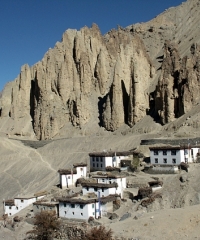India is a vast and diverse country. Extreme diversity, which permeates its culture, language, ethnicity, climate and geography, both fascinates and baffles a visitor. Located in South Asia, the country takes pride on being the largest democracy and second most populous country of the world. India is also the land of ancient civilizations. The earliest archaeological findings of human habitation has been traced back to 7000 BC. The country is believed to be the birthplace of four major religions of the world Hinduism, Buddhism, Sikhism and Jainism. The country was under Islamic occupation from 8th Century to 18th Century, before coming under the British rule. India attained independence in 1947 after a prolonged struggle.
Mother nature has bestowed natural beauty generously to India. Mountains, desert, jungles and beaches, it has all, making it a perfect holiday destination. It is bounded by Himalayas, the highest mountain range on earth, to the north. Some of the well known hill stations are Srinagar, Gulmarg (in Jammu & Kashmir), Shimla, Manali (in Himachal Pradesh), Mussoorie (in Uttarakhand) and Darjeeling (in West Bengal). The hill stations are popular among international tourists because of their snow clad peaks, picturesque landscapes and opportunities for outdoor activities.
Bound by Arabian Sea on the west and Bay of Bengal on the east, India has a long coastline of more than 7000 kilometers. Expectedly, there are countless beaches, some of them the finest in the world, dotting the long coastline. Beaches on the western coast in Goa State are popular among international tourists. These include Calangute Beach, Majorda Beach and Dona Paula Beach. Popular beaches on the eastern coast include Marina Beach (Chennai), Konark Beach and golden sand beach of Puri (Orissa). Soft sand beaches of the islands of Andaman and Nicobar and Laksadweep (both in Indian Ocean) provide and exotic experience.
For those who are fascinated with the spiritual wealth of India, a trip to its temples is a must. Most of the popular temples dates back to several centuries and are exquisite work of architecture featuring intricate stone carvings. Bhubaneswar, also known as the City of Temples in the eastern State of Orissa, boasts of more than 500 ancient temples, Lingaraja, Mukteshwar and Rajarani being the popular ones. Khajuraho Temple of the central State of Madhya Pradesh is famous for stone carvings depicting Kamasutra, the art of sex. Other important holy shrines are Jagannath Temple (Orissa), Rameshwaram Temple (in southern State of Tamil Nadu) and Somnath Temple (in western State of Gujarat). Entry to some of these temples may be restricted for non- Hindus.
Confluence of contrasting cultures has gifted Indian some of the most celebrated monuments of the world. Taj Mahal in Agra (in the State of Uttar Pradesh) is one of one of the New Seven Wonders of the World. Red Fort in New Delhi, the capital of India, is a symbol of Mughal might. Hawa Mahal in Jaipur is an example of Rajput-Mughal architecture.
India Attractions:
- Amusement Park (1)
- Bars (45)
- Beaches (5)
- Casinos (1)
- Cinemas (12)
- Clubs (10)
- Historical Spots (1)
- Internet cafes (1)
- Mosques (1)
- Museums (3)
- Parks (2)
- Restaurants (8)
- Sights (9)
- Temples (10)
- Theatres (13)
India Traveler Advice
| Female Traveler (2) | Food (1) | Health (3) |
| Itineraries (4) | Sights (3) | Transportation (1) |
| Visa (1) | Warnings (11) |
From our blogsphere:
Kerala ; Gods own country By anishwayanad
Loving Laos By Vic Lactaoen
Destinations
See All- Agra
- Ajanta Caves
- Almora
- Alwar
- Amritsar
- Andaman and Nicobar Islands
- Andhra Pradesh
- Arunachal Pradesh
- Assam
- Bihar
- Chandigarh
- Dehra Dun
- East Sikkim
- Goa
- Great western Himalayas - Himachal Prade
- More destinations
In our Magazine
Three Countries, One Day
 Thailand, Cambodia, Laos, Vietnam, Burma and China rely on the river Mekong for trade and tourism. Travelers who want to discover these countries can easily avail of cruises that last for as short as 24 hours.
Thailand, Cambodia, Laos, Vietnam, Burma and China rely on the river Mekong for trade and tourism. Travelers who want to discover these countries can easily avail of cruises that last for as short as 24 hours.
Trans-Siberian Railway: The Epic Journey Continues
 As part of the must-do list of passionate travelers, riding the Trans-Siberian Railway offers not only the beauty of passing scenery but a genuine interaction with the places where the train cuts through.
As part of the must-do list of passionate travelers, riding the Trans-Siberian Railway offers not only the beauty of passing scenery but a genuine interaction with the places where the train cuts through.
Last chance to see
 Destruction of a place is what a Hollywood doomsday film is made of but fiction does extend to reality, especially in the case of the Great Barrier Reef, the Alps, and the Red Sea which may disappear in our children’s lifetime.
Destruction of a place is what a Hollywood doomsday film is made of but fiction does extend to reality, especially in the case of the Great Barrier Reef, the Alps, and the Red Sea which may disappear in our children’s lifetime.






